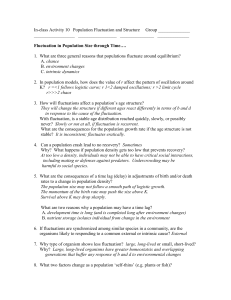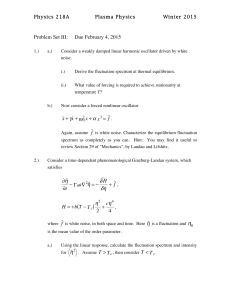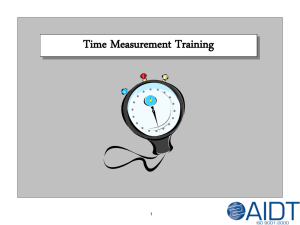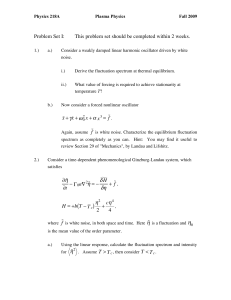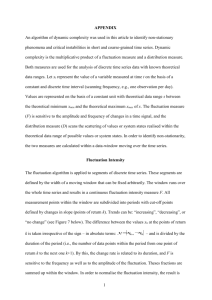Advance Journal of Food Science and Technology 11(1): 82-87, 2016 DOI:10.19026/ajfst.11.2359
advertisement
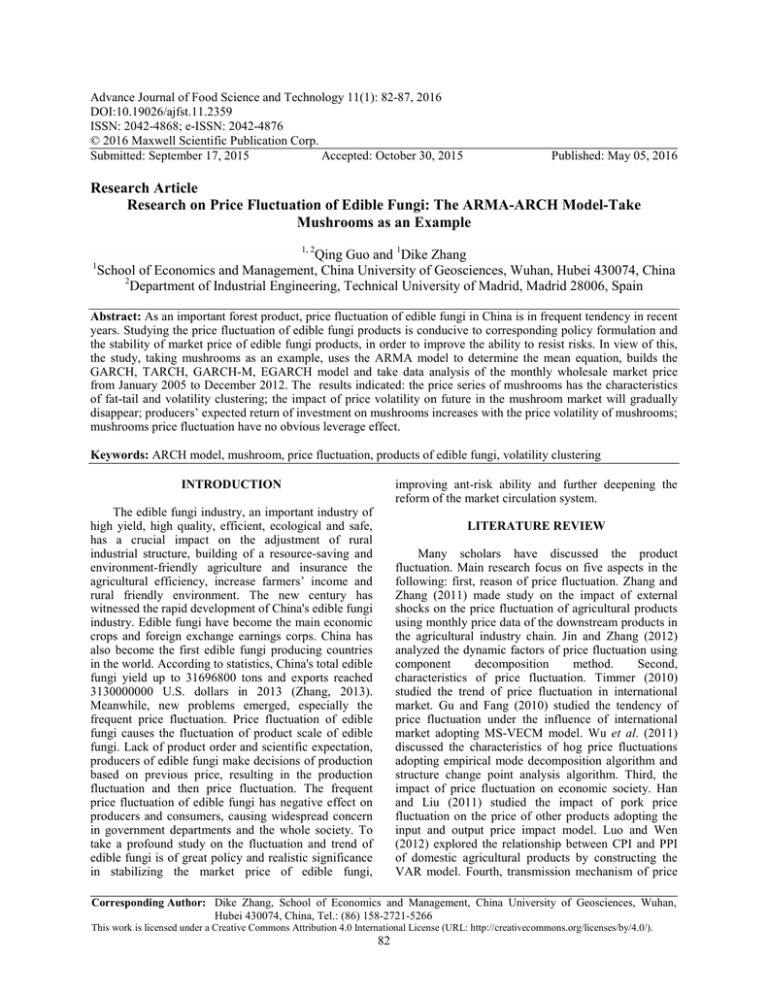
Advance Journal of Food Science and Technology 11(1): 82-87, 2016 DOI:10.19026/ajfst.11.2359 ISSN: 2042-4868; e-ISSN: 2042-4876 © 2016 Maxwell Scientific Publication Corp. Submitted: September 17, 2015 Accepted: October 30, 2015 Published: May 05, 2016 Research Article Research on Price Fluctuation of Edible Fungi: The ARMA-ARCH Model-Take Mushrooms as an Example 1, 2 1 Qing Guo and 1Dike Zhang School of Economics and Management, China University of Geosciences, Wuhan, Hubei 430074, China 2 Department of Industrial Engineering, Technical University of Madrid, Madrid 28006, Spain Abstract: As an important forest product, price fluctuation of edible fungi in China is in frequent tendency in recent years. Studying the price fluctuation of edible fungi products is conducive to corresponding policy formulation and the stability of market price of edible fungi products, in order to improve the ability to resist risks. In view of this, the study, taking mushrooms as an example, uses the ARMA model to determine the mean equation, builds the GARCH, TARCH, GARCH-M, EGARCH model and take data analysis of the monthly wholesale market price from January 2005 to December 2012. The results indicated: the price series of mushrooms has the characteristics of fat-tail and volatility clustering; the impact of price volatility on future in the mushroom market will gradually disappear; producers’ expected return of investment on mushrooms increases with the price volatility of mushrooms; mushrooms price fluctuation have no obvious leverage effect. Keywords: ARCH model, mushroom, price fluctuation, products of edible fungi, volatility clustering improving ant-risk ability and further deepening the reform of the market circulation system. INTRODUCTION The edible fungi industry, an important industry of high yield, high quality, efficient, ecological and safe, has a crucial impact on the adjustment of rural industrial structure, building of a resource-saving and environment-friendly agriculture and insurance the agricultural efficiency, increase farmers’ income and rural friendly environment. The new century has witnessed the rapid development of China's edible fungi industry. Edible fungi have become the main economic crops and foreign exchange earnings corps. China has also become the first edible fungi producing countries in the world. According to statistics, China's total edible fungi yield up to 31696800 tons and exports reached 3130000000 U.S. dollars in 2013 (Zhang, 2013). Meanwhile, new problems emerged, especially the frequent price fluctuation. Price fluctuation of edible fungi causes the fluctuation of product scale of edible fungi. Lack of product order and scientific expectation, producers of edible fungi make decisions of production based on previous price, resulting in the production fluctuation and then price fluctuation. The frequent price fluctuation of edible fungi has negative effect on producers and consumers, causing widespread concern in government departments and the whole society. To take a profound study on the fluctuation and trend of edible fungi is of great policy and realistic significance in stabilizing the market price of edible fungi, LITERATURE REVIEW Many scholars have discussed the product fluctuation. Main research focus on five aspects in the following: first, reason of price fluctuation. Zhang and Zhang (2011) made study on the impact of external shocks on the price fluctuation of agricultural products using monthly price data of the downstream products in the agricultural industry chain. Jin and Zhang (2012) analyzed the dynamic factors of price fluctuation using component decomposition method. Second, characteristics of price fluctuation. Timmer (2010) studied the trend of price fluctuation in international market. Gu and Fang (2010) studied the tendency of price fluctuation under the influence of international market adopting MS-VECM model. Wu et al. (2011) discussed the characteristics of hog price fluctuations adopting empirical mode decomposition algorithm and structure change point analysis algorithm. Third, the impact of price fluctuation on economic society. Han and Liu (2011) studied the impact of pork price fluctuation on the price of other products adopting the input and output price impact model. Luo and Wen (2012) explored the relationship between CPI and PPI of domestic agricultural products by constructing the VAR model. Fourth, transmission mechanism of price Corresponding Author: Dike Zhang, School of Economics and Management, China University of Geosciences, Wuhan, Hubei 430074, China, Tel.: (86) 158-2721-5266 This work is licensed under a Creative Commons Attribution 4.0 International License (URL: http://creativecommons.org/licenses/by/4.0/). 82 Adv. J. Food Sci. Technol., 11(1): 82-87, 2016 fluctuation (He et al., 2008) studied the transmission path of price fluctuation trend. Hu and Li (2010) analyzed the relation of vertical price transmission and vertical market connection. Fifth, countermeasures to stabilize price fluctuations. Respectively, studied the countermeasures for price volatility from different aspects (Zhang et al., 2012; Li et al., 2012). Researches above shed light on the paper. However, some issues are to be discussed. First, few study of price fluctuation adopts ARCH model, especially few constructs equation by ARCH model. Second, few study focus on the price fluctuation of edible fungi. In fact, study on the price fluctuation of edible fungi is of great importance. First, Food and Agriculture Organization of the United Nations has pointed out that scientific diet structure is with a meat, a vegetarian and a mushroom a day in the twenty-first Century. Study of price fluctuation of edible fungi can help consumers scientifically expect the price. Second, U. S. Wall Street subprime mortgage crisis has a great impact on the world and China's economy, so study of price fluctuation of edible fungi can help stabilize the forest market and improve the ability to resist risks. Third, price fluctuations have important influence on the decision making behavior of producers, research on the price fluctuation of edible mushrooms can provide reference for the government departments to stabilize the price of edible fungi. In view of this, the study, taking mushrooms as an example, uses the ARMA model to determine the mean equation, builds the GARCH, TARCH, GARCH-M, EGARCH model and take data analysis of the price fluctuation of edible fungi. The main points of the research are as follows: Does the price fluctuation of the mushroom have the characteristics of the volatility cluster? What is the future trend of the price fluctuation of mushrooms? What are the producers' expectations of the market for the mushroom products? Does the price fluctuation of mushroom have leverage effect? • • yt = xt' β + ε t (1) ht = α 0 + α 1ε t2−1 + L + α q ε t2− q + θ1ht −1 + L + θ p ht − p (2) Is a conditional mean equation, where x't is independent variable and yt may be seen as yield of mushrooms. In the study, which only includes delay term of yt, error terms εt are subject to the normal distribution of the expected value 0 and the variance σ2. Is a conditional variance, in which p and q is respectively the lag order of ARCH and GARCH. Expect risk of producers to the market: In the study, ARCH-M model is adopted to test expect risk of producers to mushrooms market. ARCH-M model introduces conditional variance to the mean equation (Engle et al., 1987), which add ht as one of the explanatory variables that affect the economic time series to (1). The model is given by: yt = xt' β + γht + ε t (3) In (3), γ may be seen as factor of market risk, representing fluctuation degree of mushrooms market. Leverage effect of price fluctuation: In the study, TARCH model an EGARCH model are adopted to verify whether the price fluctuation of mushroom have leverage effect or not. TARCH model introduced by Rabemananjara and Zakoian (1993) is given by: q p i =1 i =1 ht = α 0 + ∑ α i ε t2−i + ϕε t2−1d t −1 + ∑ θ i ht − j (4) After introducing dt, price fluctuation of mushrooms will have different effect on conditional variance. For producers, price increase will be good news when εt>0 and we get the impact coeffiency of price fluctuation to price return rate α1 + α2 +…+αi. On the contrary, price fall will be bad for producers when εt<0 and we get the impact coeffiency of price fluctuation to price return rate α1 + α2 +…+αi + φ. If φ ≠ 0, price fluctuation of mushroom have leverage effect on price return rate. If φ>0, price fluctuation will strengthen. If φ<0, price fluctuation will be weakened. EGARCH model introduced by Nelson (1991) is given by: METHODOLOGY ARMA model is usually used for economic equation with volatility clustering. The paper adopts the ARMA model to determine the price fluctuation of Chinese forestry products and builds the GARCH, TARCH, GARCH-M, EGARCH model. Volatility clustering of price fluctuation: In the study, GARCH model is adopted to test whether the price of mushroom is clustering and to analyze the future trend of price fluctuation. GARCH model introduced by (Bollerslev, 1986) explicitly describes certain economic time series with small computation that the order number q needs to take a larger value. The model is given by: p q ε ε log(ht ) = α0 + ∑θ j log(ht − j ) + ∑αi t −i + ϕi t −i h ht −i i =1 i =1 t −i (5) In (5), ht is a natural logarithm, φ may be used to verify whether the price fluctuation of mushroom have leverage effect or not. 83 Adv. J. Food Sci. Technol., 11(1): 82-87, 2016 Table 1: Statistical characteristics of price earnings ratio Parameter Data Mean 0.007 Median -0.002 Maximum value 0.609 Minimum value -0.691 Standard deviation 0.180 Skewness -0.429 Kurtosis 6.639 JB normal test 48.364 Associated probability 0.000 The original hypothesis of JB normal test is that the sample is subject to normal distribution and the data in the table are rounded to the nearest integer probability in recent years. Associated probability of JB normal test P = 0.0000, showing that in at least 99% of the confidence level the sample price return sequence reject the distribution of the normal distribution, that is, the probability of extreme changes in mushrooms price is far higher than the probability of normal distribution. DATA ANALYSIS Stationary unit root test: Time series for measurement analysis must be generated by a stationary random process. If a time series is non-stationary, stationary, then we can study the behavior characteristics in a specific period of time. Then the conclusion is in particularity and could not bee extended to other period (Damodar, 2010). Obviously, the real value of non-stationary stationary time series is not good. In the study,, the root test unit is used to determine the stability of time series of the price earnings ratio. If it is assumed that the test model includes intercept but not trend term, the result is shown in Table 2. From Table 2, we can see that in the 1, 1 5, 10% significant level, we should reject the assumption that the price of mushrooms should be random, that is, there is no unit root. Data sources: In order to eliminate the price impact from individual retail vendors, the data used in the study is based on the monthly average price data (Yuan/kg) of wholesale market from January 2005 to December 2012 announced by Chinese Edible Fungi Business Website www.mushroommarket.net www.mushroommarket.net. One thing to mention, Mushrooms oms here are fresh mushrooms and quick frozen foods, dry products and salted products are not included. To calculate the mushroom price, the paper adopts the first order differential form in the next month, that is, yt = ln pt – ln pt-1, where pt is the mushroom price in month t and yt may be used to the monthly mushrooms yield sequence. According to Eviews 6.0, we get the data in the following Table 1. We can see statistical characteristics of price earnings ratio in Table 1. Mean of mushroom price is 0.77%, close to 0. Skewness of mushrooms price S = 0.429<0, 0, Kurtosis of mushrooms price K = 6.639>3. Compared with the standard normal distribution (S = 0, K = 3), Mushroom price income rate is in a left leaning, spike distribution and show that profit pro probability of mushroom producers will be less than the loss Seasonal unit root test: Time series is the seasonal variation of the observed values. In the th paper, whether the correlation coefficient when the seasonal cycle k = 12 is with significant difference with 0 is measured to determine whether the price of the mushrooms are seasonal. Figure 1 is to show auto-correlation auto and partial auto-correlation analysis of mushroom prices return. When K = 12, the autocorrelation coefficient of the sequence is -0.088, showing that mushrooms price fluctuation is not seasonal inn the random range. Table 2: Results of unit root test 10% 5% 1% Stable or not Test (C, T, L) ADF (C, 0, 1) -12.391*** -2.586 -2.897 -3.512 Stable Eviews6.0 software is used for unit root test; test C, T, L respectively represents intercept, trend and lag order number. Lag order number is chosen according to the minimum criterion between AIC and SC information value. In the paper, when lag order number is 1, tes test results of auxiliary equation show AIC and SC value is the minimum, respectively, -0.6442 and -0.5855; 0.5855; examination of the original hypotheses includes unit root; ***: is used when t is less than the critical value of 1% significant level, that is, we can reject the null hypothesis in at leas least 99% confidence level Fig. 1: Auto-correlation and partial auto-correlation correlation analysis 84 Adv. J. Food Sci. Technol., 11(1): 82-87, 2016 Table 3: Model parameter estimation and test results R² AIC SC AR (2) 0.103 -0.647 -0.587 ARMA (2, 1) 0.179 -0.712 -0.622 Eviews6.0 software is used for model parameter estimation and test results. The minimum information criterion among Coefficient of determination after adjustation, AIC and SC is considered as an important basis for selecting the ARMA model significant. Thus, the price fluctuation of mushrooms does not have a significant leverage effect. Cause analysis of volatility: The paper tries to explain the volatility from the perspective of Circulation Economics. First, slow growth of the main body of the market circulation leads to mushroom price fluctuation. As one important part of the circulation system construction, the farmer’s brokers, agents, private traders and other market entities have a certain role in promoting the circulation of agricultural products. While, because of the restriction of the education level, age and the living environment of rural area, it is difficult for them to meet the competitive environment of modern market (Ke, 2003). To some extent, it leads to the price fluctuation of the mushrooms. Second, according to the cobweb theory, price fluctuation of products will cause the fluctuation of the production scale. Lack of order and reasonable expectation, scattered farmers make current production decision based on previous price, resulting in production scale fluctuations between years, in turn and leading to the price fluctuation. Third, farmers’ market circulation consciousness and cognition level is relatively weak, especially in the mushroom market price information and farmers’ individual cognitive differs from each other. Some farmers do not understand the market preference and the highest price of the wholesale market, resulting in the gap between production and demand and then to a certain extent, leading to the price fluctuations of agricultural products (Li et al., 2010). Mean equation: In Fig. 1, we can obviously see that partial correlation coefficient of lag 1 and lag 5 is not 0. When k>5, data of Q show that the sequence is not auto-correlated. Therefore, AR (2) or ARMA (2, 1) model can be used to fit the data of mushroom yield. By comparing AIC and SC values of the two models, we can find that AIC and SC values get to the minimum, 0.712 and -0.622 in ARMA (2, 1) model. And coefficient of determination after adjustation is also relatively high. So ARMA (2, 1) model is more suitable for the conditional mean value equation (Table 3). Volatility analysis: Volatility Analysis of mushrooms market is as following: (Table 4). Cluster analysis: From the results of the ARMAGARCH model, it is very significant that the coefficient of ARCH α1<5%, which is obviously a cluster of mushroom price fluctuations. Since α1+θ1 = 0.981<1, the model is wide, stable and predictable. It can be seen that past price fluctuation in mushrooms market has a lasting effect on the future and will gradually disappear with the relatively slow speed. Expectation risk analysis of producers to the market: From the results of the ARMA-GARCH model, ht = 0.047, we can see that with the increase of price volatility, the expected return on investment of the mushroom producers also increase. The coefficient pass the significant test at 1% confidence level, which show return has a positive risk premium and also show that the mushroom market has the characteristics of high investment, high risk and high return. CONCLUSION In the life cycle of any industry, due to the role of the invisible hand, price fluctuations will often occur. The cobweb theory also shows that price fluctuations of products will cause the fluctuation of the production scale of products. Lack of order and reasonable expectation, scattered farmers make current production decision based on previous price, resulting in production scale fluctuations between years, in turn and leading to the price fluctuation, which is not conducive to the interests of farmers and also not conducive to industrial development. Although price fluctuation is Analysis of leverage effect of volatility: From the results of the ARMA-TARCH model, the estimated value of φ = 0.377>0, which is not significant. From the results of the ARMA-EGARCH model, the estimated value of φ = -0.142, which is also not Table 4: Estimated results of ARMA-ARCH model ARMA-GARCH ARMA-GARCH-M ARMA-TARCH ARMA-EGARCH AR (1) 0.628*** (3.797) 0.703*** (5.220) 0.658*** (4.038) 0.663*** (4.301) AR (2) 0.086 (0.605) -0.042 (-0.290) 0.055 (0.695) 0.025 (0.166) MA (1) -0.933*** (-29.673) -0.979*** (-65.201) -0.929*** (-27.146) -0.914*** (-26.982) 0.002 (1.441) 0.001 (0.897) 0.002 (1.294) -1.202** (-2.530) α0 0.506** (2.018) 0.817** (2.298) 0.529* (1.886) 0.894*** (2.604) α1 θ1 0.475*** (3.066) 0.408*** (2.977) 0.448*** (3.111) 0.861*** (9.505) 0.047*** (5.019) ht φ 0.377 (0.605) -0.142 (-0.767) The values in parentheses represents z, *: indicates significant at the 10% confidence level and the; **: indicates significant at the 5% confidence level and ***: indicates significant at 1% confidence level 85 Adv. J. Food Sci. Technol., 11(1): 82-87, 2016 inevitable, we can effectively mitigate the risk of loss after full study and analysis of the characteristics and trends of price fluctuations. The paper, taking mushrooms as an example, uses the ARMA model to determine the mean equation, builds the GARCH, TARCH, GARCH-M, EGARCH model and takes data analysis of the monthly wholesale market price from December 2012 to January 2005. It draws the conclusion as following: supported by the Natural Science Foundation of China (NSFC) (No. 71173201) and (No. 71473231). REFERENCES Bollerslev, T., 1986. Generalized autoregressive conditional heteroskedasticity [J]. J. Econometrics, 31: 307-328. http://www.unc.edu/~jbhill/ Bollerslev_GARCH_1986.pdf. Damodar, N.G., 2010. Basic Econometrics [M]. China Renmin University Press, Beijing, China. Engle, R.F., D.M. Lilien and R.P. Robins, 1987. Estimating time varying risk premia in the term structure: The ARCH-M model [J]. Econometrical, 55(2): 391-407. http://www.researchgate.net/ publication/4814948_Estimating_Time_Varying_R isk_Premia_in_the_Term_Structure_The_ArchM_Model. Gu, G.D. and C.L. Fang, 2010. The volatility analysis of China agricultural price-based on the transfer model under the influence of the international market factors [J]. Chinese Rural Econ., 6: 67-76. Han, Y.J. and X.L. Liu, 2011. The price fluctuation of Chinese pork impact on other sectors product prices and CPI estimation [J]. Chinese Rural Econ., 5: 12-20. He, L.P., G. Fan and X.N. Hu, 2008. CPI vs. PPI: Which drives which? [J]. Econ. Res. J., 11: 16-26. Hu, H.P. and C.G. Li, 2010. The vertical prices transfer of agricultural products and couples with longitudinal market [J]. Issues Agric. Econ., 1: 10-17. Jin, S.L. and J.X. Zhang, 2012. The characteristics and influence factors of international major agricultural products prices fluctuation [J]. Econ. Rev., 3: 29-36. Ke, B.S., 2003. Improve agricultural market system, increase circulation efficiency of agricultural products [J]. Manage. Admin. Rural Cooperative, 2: 10-11. Li, J., D.S. Li and Y. Lan, 2012. Fluctuations in property and stabilize mechanism selection of Chinese food price [J]. J. Agrotech. Econ., 7: 39-47. Li, P., W.W. Wang and J.B. Zhang, 2010. Economics analysis of farmers on market circulation cognition-as the mushroom growers for example [J]. China Rural Surv., 6: 44-53. Nelson, D.B., 1991. Conditional heteroskedasticity in asset returns: A new approach [J]. Econometrical, 59: 347-70. https://ideas.repec.org/a/ecm/ emetrp/v59y1991i2p347-70.html. Rabemananjara, R. and J.M. Zakoian 1993. Threshold arch models and asymmetries in volatility. J. Appl. Econom., 8(1): 31-49. http://onlinelibrary.wiley. com/doi/10.1002/jae.3950080104/abstract. The price series of mushrooms has the characteristics of fat-tail and volatility clustering: After a big fluctuation, the mushroom prices tend to be accompanied by another big fluctuation, which is likely to produce another smaller fluctuation after a small fluctuation. The volatility clustering of price, in some extent, is due to the imperfect current system of China's forest products circulation. Therefore, it is necessary to further accelerate the development of forest products market circulation, strengthen agricultural super docking and improve the agricultural information service system construction, which will ease alleviate price volatility. The impact of price volatility on future in the mushroom market is lasting but will gradually disappear in a long run: Therefore, if there is large price fluctuation in the market, it is hard to eliminate the effect in short time. What government should do is to take countermeasures to stabilize the market price in time. Producers’ expected return of investment on mushrooms increases with the price volatility of mushrooms: With the characteristics of high investment, high risk and high return, mushrooms are different from other agricultural products like rice, wheat, corn and sorghum. Therefore, to different products, corresponding policy should be made for stability and prosperity of the market. Mushrooms price fluctuation has no obvious leverage effect: Therefore, when the price is up or down, government should pay attention to the fluctuation to prevent the adverse impact on economy. There is still some questions worth to be further discussed. First, in the study, price data for frozen food, dry goods and salt products are not included. Second, the paper analyzes the effect of current market circulation, but it is not included in the mean equation as an economic variable. Third, price fluctuation, in some extent, is the result of market readjustment and is good for economy. The reasonable price fluctuation extent is worthy for further study in the future. ACKNOWLEDGMENT The authors would like to thank the anonymous referees for constructive suggestions. This research is 86 Adv. J. Food Sci. Technol., 11(1): 82-87, 2016 Timmer, C.P., 2010. Reflection on food crisis past. Food Policy, 35(1): 1-11. http://www. sciencedirect.com/science/article/pii/S0306919209 001092. Wu, D.S., J.P. Li, L. Tang, R.H. Deng and X.G. Yang, 2011. A hybrid analysis model for fluctuation characteristics and influence events of live pig price and an empirical study [J]. Syst. Eng. Theor. Pract., 11: 2033-2042. Zhang, D.P., Z. Guo and P.P. Liu, 2012. Home and abroad in food price volatility by the year of 20002011: Influence factors and revelation [J]. Inquiry Econ. Issues, 3: 163-169. Zhang, J.B., 2013. Research on Economic Development of China Mushroom Industry [M]. Science Press, Beijing. Zhang, L.Y. and X.C. Zhang, 2011. Research on the effect of external shocks on price volatility of agricultural products-based on agricultural industry chain perspective [J]. Manage. World, 1: 71-81. 87
